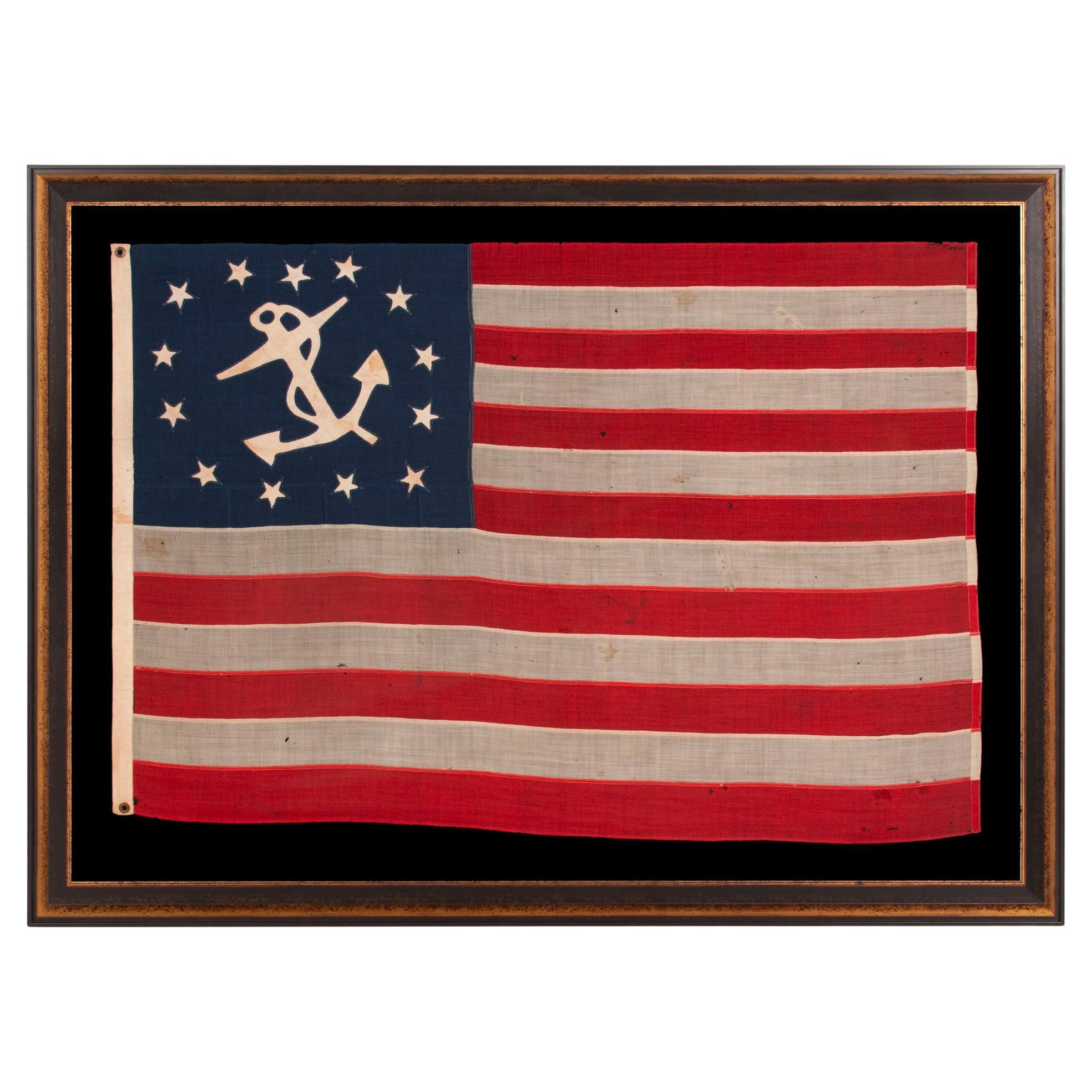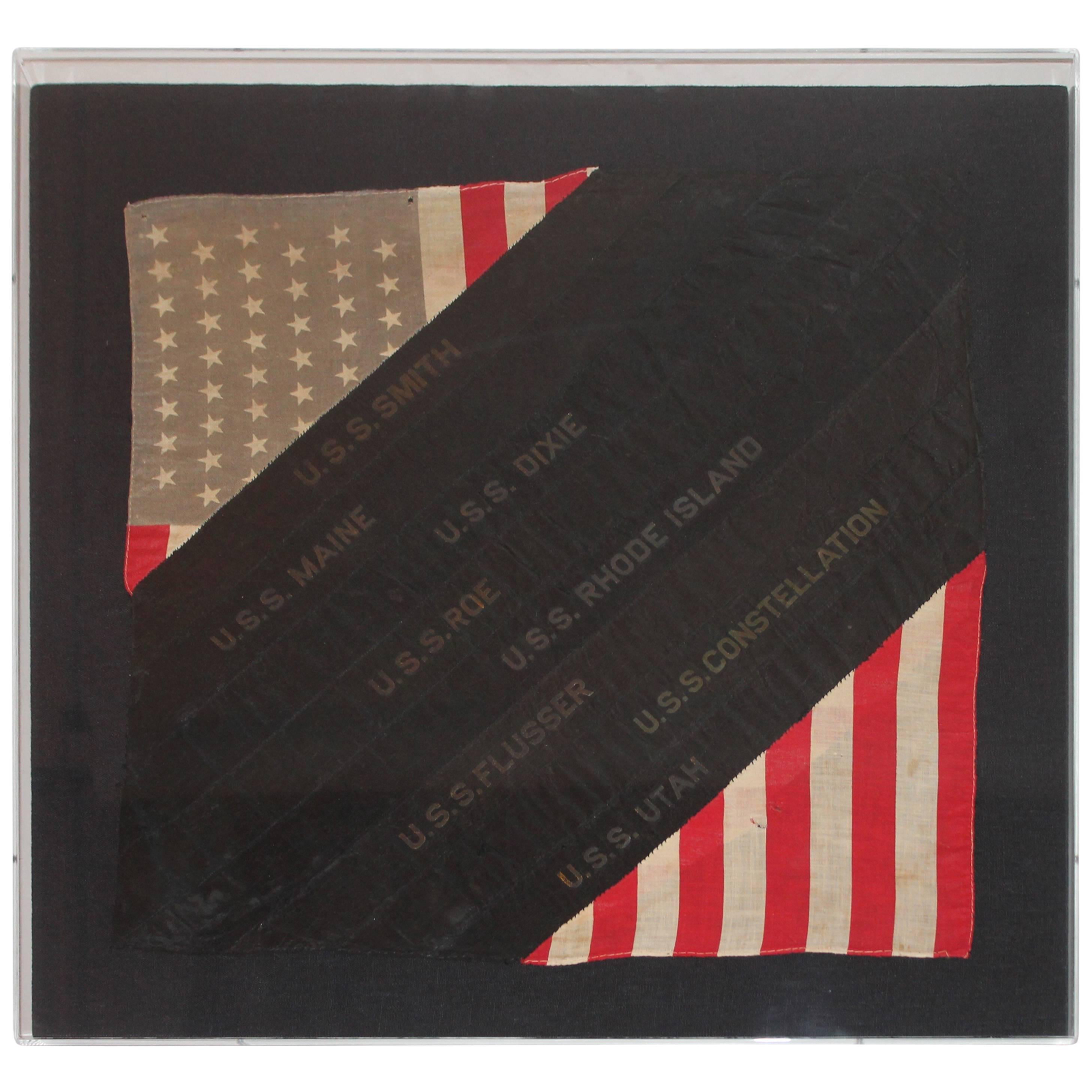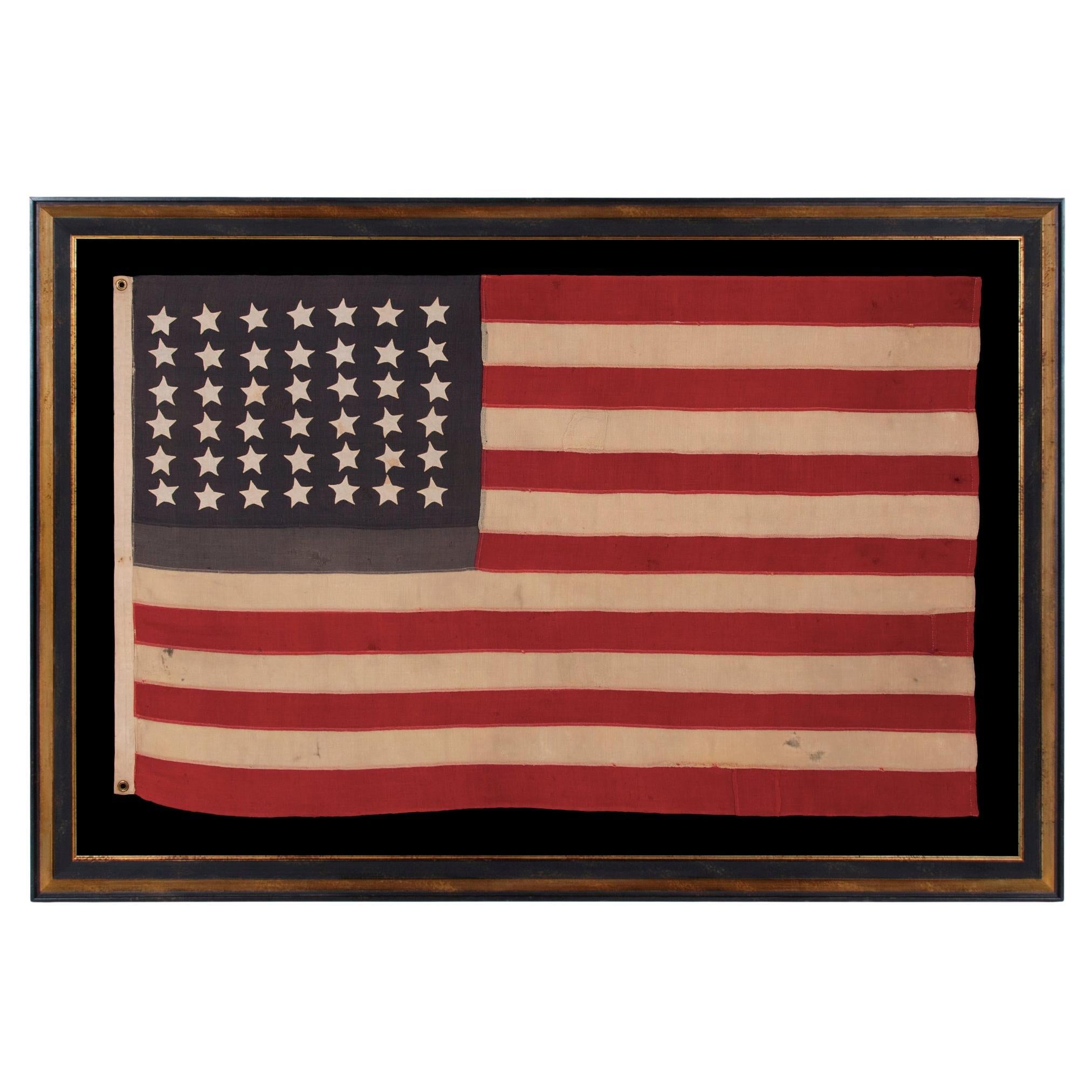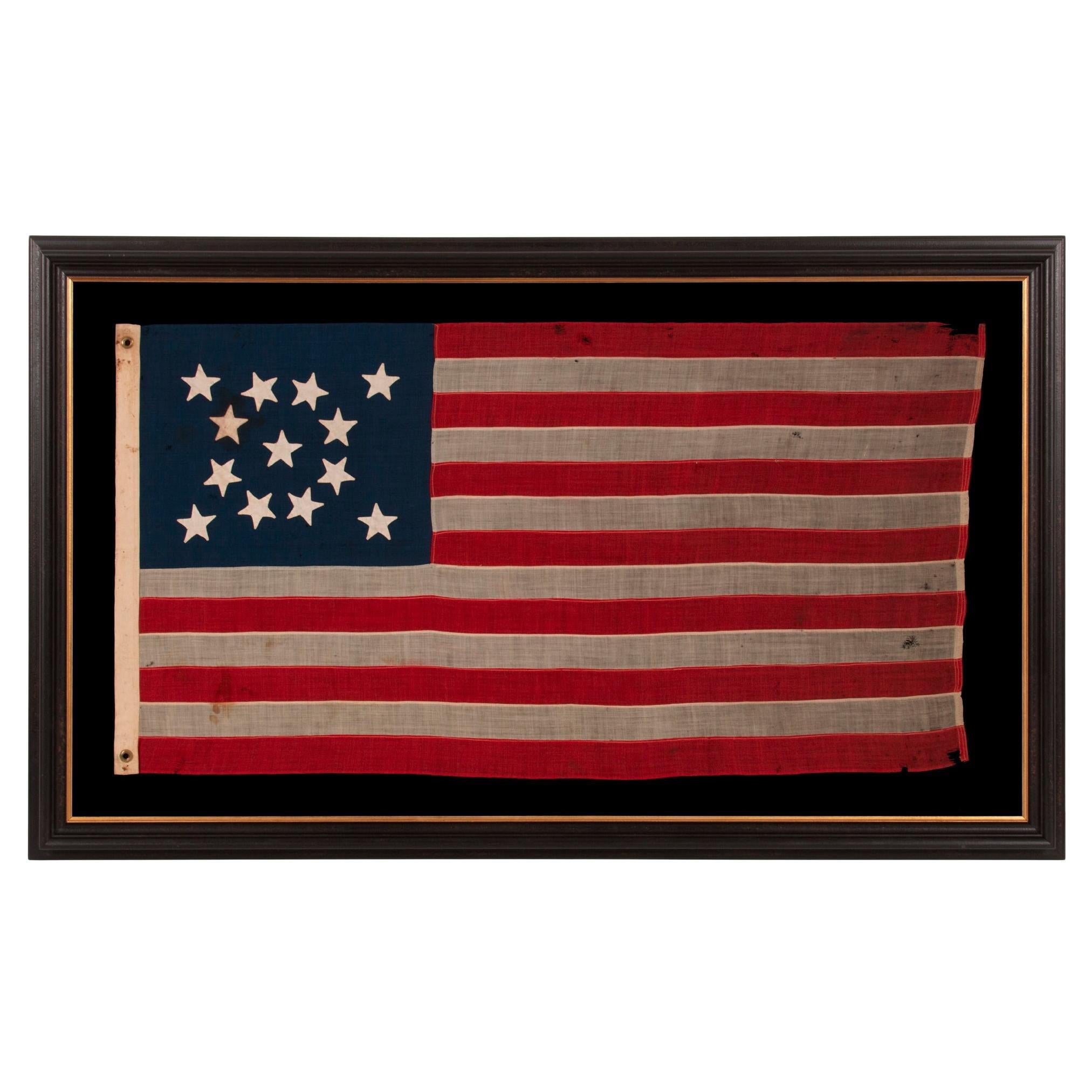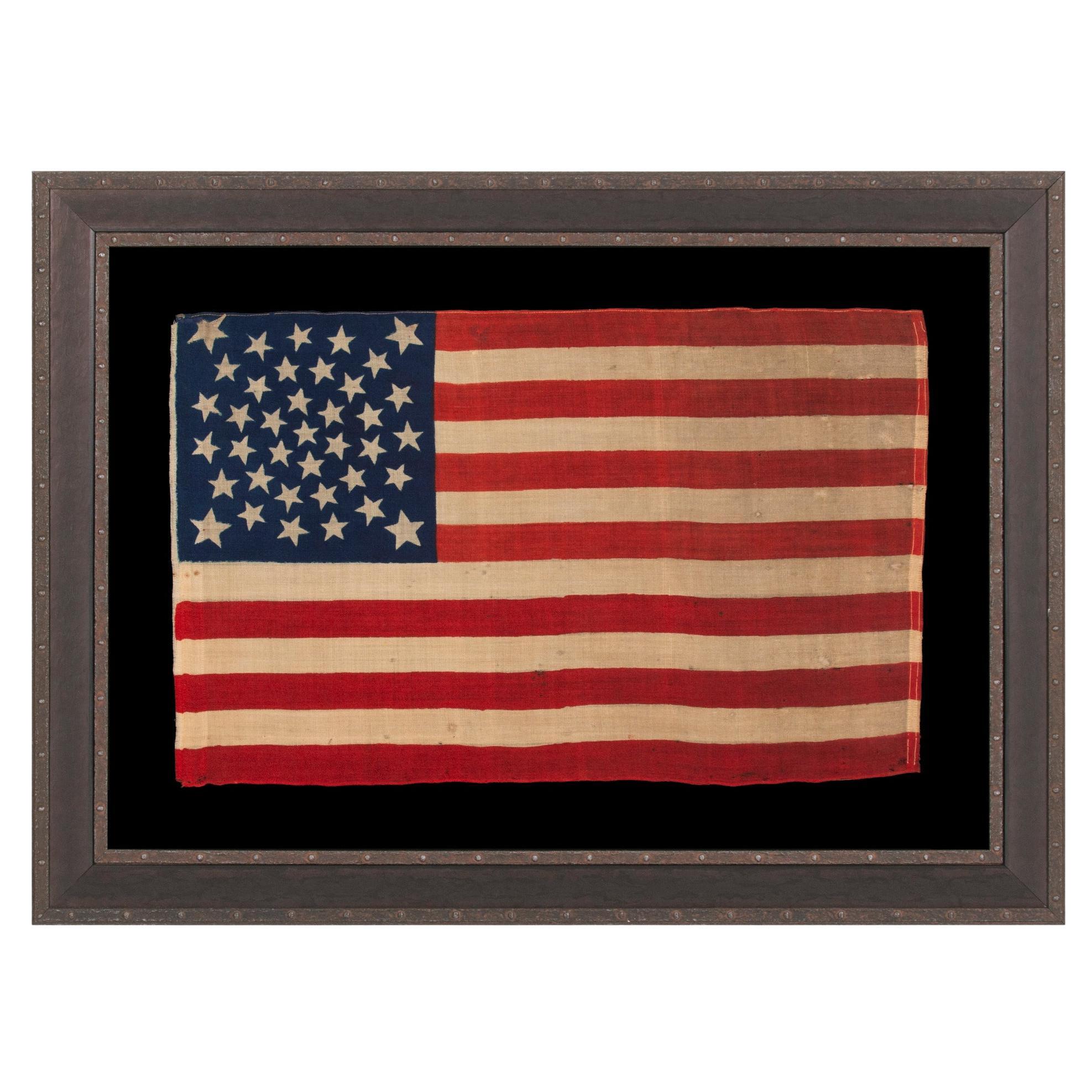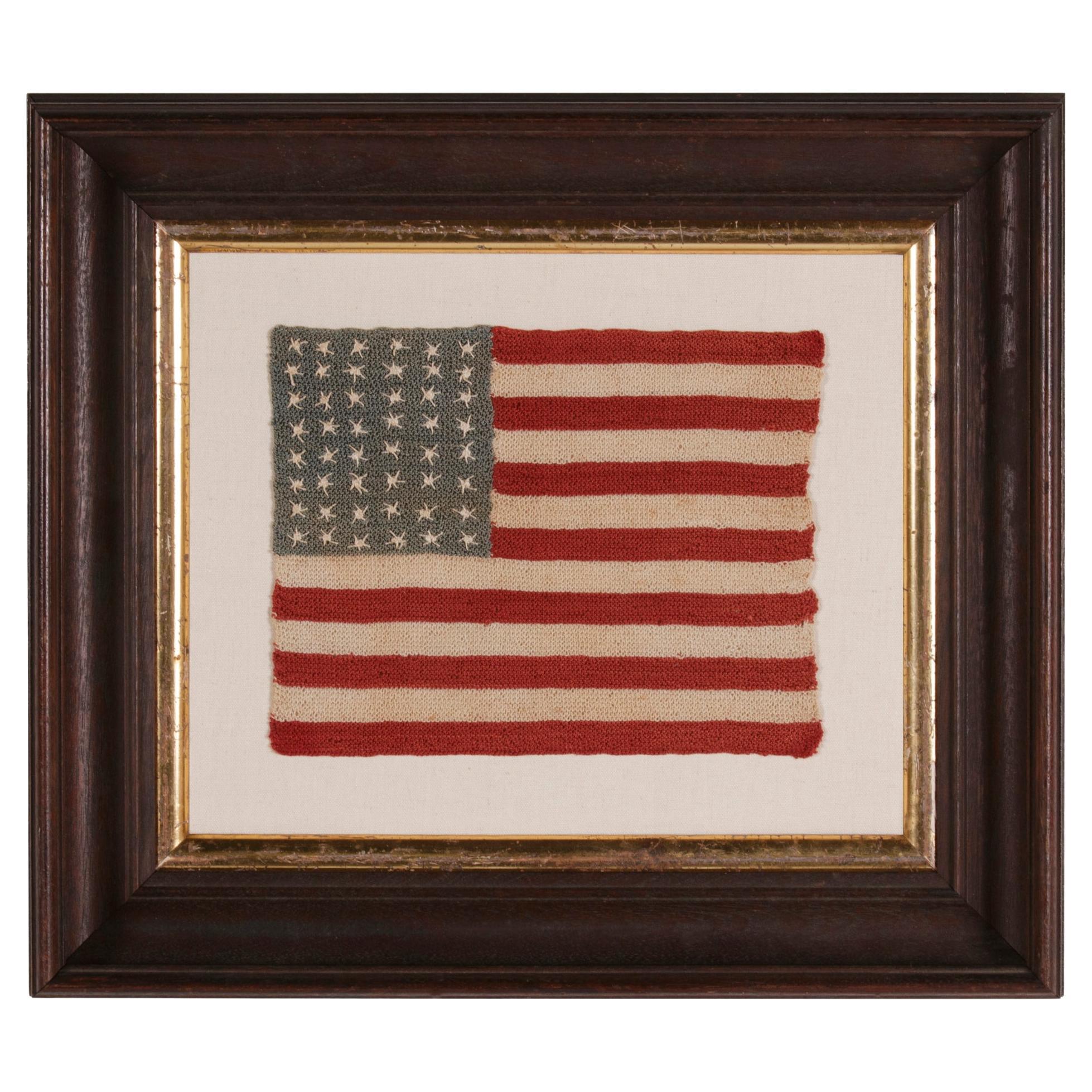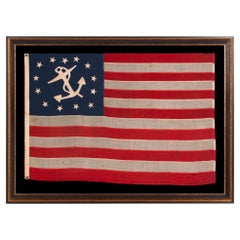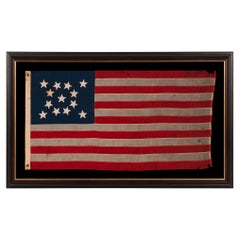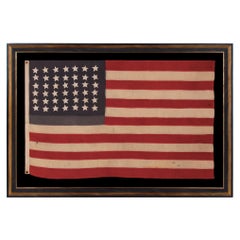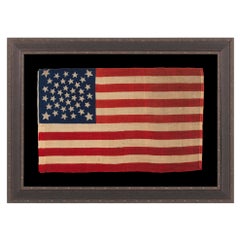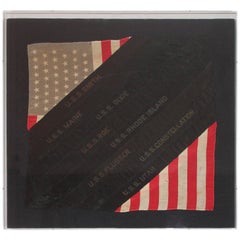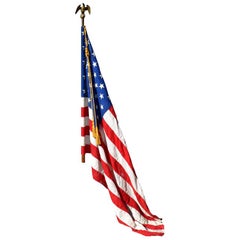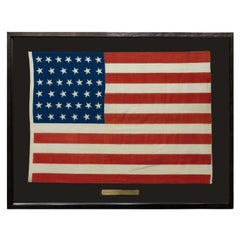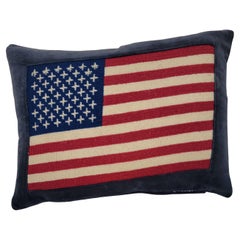Items Similar to 14 Star, Hand-Sewn Flag with Appliqued Eagle, Made by Sarah McFadden, ca 1852-73
Want more images or videos?
Request additional images or videos from the seller
1 of 6
14 Star, Hand-Sewn Flag with Appliqued Eagle, Made by Sarah McFadden, ca 1852-73
About the Item
ENTIRELY HAND-SEWN FLAG WITH AN APPLIQUED FEDERAL EAGLE AND 14 STARS, MADE IN THE 1850’s BY RENOWNED FLAG MAKER SARAH McFADDEN, “THE BESTY ROSS OF NEW YORK,” FOR THE HUDSON RIVER STEAMSHIP “DELAWARE,” LAUNCHED, 1852; CONSCRIPTED INTO FEDERAL SERVICE BY THE U.S. NAVY AS A CIVIL WAR GUNBOAT IN 1860 (RENAMED U.S.S. DELAWARE, 1861-1865); SOLD TO THE U.S. REVENUE MARINE, WHERE IT SERVED FOR 38 YEARS (1865-1903), FIRST AS U.S.R.C. DELAWARE, THEN AS THE U.S.R.C. LOUIS McCLANE
1852-1860 flag with a white ground, featuring a red, hand-sewn, single-appliqued eagle, surrounded by 14, hand-sewn, indigo blue stars, inscribed "Delaware" along the hoist binding; Made by Sarah Mc Fadden of New York City for the 1852 Steamboat 'Delaware,' conscripted into federal service to become Civil War gun boat U.S.S. Delaware (1861-1865), then a U.S.S. Revenue Cutter U.S.R.C. (1865-1903); Re-named the U.S.R.C. Louis McLane in 1873, then the Louis Dolive in 1903, when it was removed from service and sold to the private sector as a merchant steamer.
The 1852 painting by J. & J. Bard, celebrated illustrators of Hudson River Steamers, shows the vessel with a very similar flag in Navy Blue, with an arch of 15 stars.
“Sally Ann” (Sarah Ann) McFadden (1808-1904), worked at 198 Hudson Street in New York City. Dubbed “New York’s Betsy Ross,”. beginning in 1834 and for more than 70 years that followed, Sarah and her descendants produced flags for every sort of purpose. Working under her own name, then under “S. McFadden & Co.” (beginning approx. 1865-67), her clients included private citizens to merchants and ship owners, yachtsmen, steamship authorities, federal, state and local governments, U.S. military and national guard units, and even the Confederacy. She sold bunting by the yard for flag-making, rented flags, banners, and patriotic draping, and performed flag repair. During the Civil War era, Sally’s firm was extremely active, supplying both the North and the South both before the war and after it began. One 1875 advertisement noted “Always on hand Ensigns, Jacks, Flys, Commercial Code of Signals.”
In addition to large, sewn flags, it is extremely likely that the McFaddens also produced some of the first printed flags. Both of Sally Ann’s grand-nephews, Levi Hitchcock Harrison and James W. Harrison, who resided with her, worked for her, and took over the business, were trained as printers. It thus stands to reason why an 1896 article in the New York Tribune reported that “At the time of the [Civil] war, Miss McFadden gave away so many flag to the school children that the police asked her to desist because children blocked up Hudson-st.” These would have been small, printed flags. The article goes on to explain that “It had become her custom to give away flags to the children on every 4th of July for a number of years.”*
While the flag presented here is unmarked, the composition of the McFadden eagle, in both fabrics and appliqué work, is very distinctive. Though very few flags survive that include them, I have owned and/or personally handled most of the ones that exist and have been able to study them first-hand. Some McFadden flags are signed by way of a black-inked stencil, but like most flag makers of the 19th century, the McFaddens appear to have signed very little of what they produced. Another major New York maker, Annin, was comparatively lax in this regard. Although in business from the 1820’s onward (still active today), Annin appears to have signed nothing until the 1864-1867 era, and afterwards sporadically at best. Across the board, flags were generally unmarked by the maker until the 48 star era (1912-1959).
* Many thanks to David Martucci for the information on Sarah McFadden included here, referenced from a research paper he compiled entitled “The McFadden-Harrison Flag Making Dynasty” (March 1st, 2016).
Mounting: The flag was mounted and framed in our own conservation department, which is led by expert staff. We take great care in the mounting and preservation of flags and have framed thousands of examples.
The flag was first stitched to supportive fabrics throughout, on the reverse. It was then hand-stitched to a background of 100% cotton twill, black in color, that was washed and treated for colorfastness. The mount was placed in a cove-shaped molding with a rope style inner lip and very dark brown, nearly black surface, with reddish highlights, to which a flat profile molding, with a finish like early gunmetal, was added as a liner. The glazing is U.V. protective acrylic (Plexiglas).
Condition: Please inquire for a full report.
Frame Size (H x L): Approx. 60" x 84"
Flag Size (H x L): 47.75" x 72"
- Dimensions:Height: 60 in (152.4 cm)Width: 84 in (213.36 cm)Depth: 2.5 in (6.35 cm)
- Materials and Techniques:
- Place of Origin:
- Period:
- Date of Manufacture:1852-1873
- Condition:See Item Description.
- Seller Location:York County, PA
- Reference Number:Seller: 14j-8131stDibs: LU849743197652
About the Seller
5.0
Recognized Seller
These prestigious sellers are industry leaders and represent the highest echelon for item quality and design.
Established in 1991
1stDibs seller since 2008
69 sales on 1stDibs
Typical response time: 1 to 2 days
- ShippingRetrieving quote...Shipping from: York County, PA
- Return Policy
Authenticity Guarantee
In the unlikely event there’s an issue with an item’s authenticity, contact us within 1 year for a full refund. DetailsMoney-Back Guarantee
If your item is not as described, is damaged in transit, or does not arrive, contact us within 7 days for a full refund. Details24-Hour Cancellation
You have a 24-hour grace period in which to reconsider your purchase, with no questions asked.Vetted Professional Sellers
Our world-class sellers must adhere to strict standards for service and quality, maintaining the integrity of our listings.Price-Match Guarantee
If you find that a seller listed the same item for a lower price elsewhere, we’ll match it.Trusted Global Delivery
Our best-in-class carrier network provides specialized shipping options worldwide, including custom delivery.More From This Seller
View AllOutstanding 13 Star Hand-sewn American Private Yacht Flag, ca 1865-1885
Located in York County, PA
OUTSTANDING, 13 STAR, ANTIQUE AMERICAN PRIVATE YACHT ENSIGN WITH GREAT FOLK QUALITIES THAT INCLUDE AN UNUSUALLY WIDE ANCHOR AND A DECIDEDLY LOPSIDED RING OF 13 STARS; MADE DURING THE 2ND HALF OF THE 19TH CENTURY; ITS DEVICE HAND-SEWN AND SINGLE-APPLIQUÉD
Private yacht ensigns were approved American signals for maritime use that allowed pleasure boats to bypass customs. Though the legislation that approved them was adopted prior to 1850, almost all such flags that one will encounter were sewn by electric machine and made during the 20th century. The unusual gems among surviving examples are those that are earlier and include hand-sewn elements. Even more rare are a select few with atypical graphics. Barely any fall into both of these categories at once. Take note of the anchor on this particular flag, wide a long horizontal crossbar (stock) that contributes to uncommonly wide stance. Set within a ring of stars that is decidedly lopsided, the result is as bold as it is endearingly whimsical—two of the best qualities in American folk art, a category in which this particular example can be filed. While I have owned 13 star private yacht flags that have displayed star and canted anchor devices that were somewhat larger and/or bolder than typical, I cannot recall any that were so graphically intriguing as this one.
Brief History of Private Yacht Ensigns:
The medallion configuration, 13-star, 13-stripe flag, with a canted center anchor was entered into official use in 1848, following an act of Congress, that made it the official signal for U.S. pleasure sailing vessels. The need for such a flag arose with the popularity of boating as a pastime for well-to-do Americans, and as a competitive sport, in addition to its longstanding utilitarian role as a vehicle of trade. In early America, all boats were subject to customs searches at every port. Without modern income tax, the federal government derived its revenues mostly from tariffs, so an accounting of foreign goods on ships was a critical venture. As yachting for pleasure became more prevalent, however, more and more time was spent searching boats that had no such inventory, wasting time for both customs officials and wealthy ship owners.
John Cox Stevens, a former president of the Jockey Club and future founder of the Union League Club, became the New York Yacht Club’s Commodore upon its founding in 1845. In 1847 he approached the secretary of the treasury and suggested that something be done to streamline the customs process for non-trade vessels. In 1848, legislation passed Congress requiring registration of these boats, which could then fly the “American Yachting Signal” to bypass customs. This remained on the books until the 1980’s, when the 1848 legislation was revoked, but the use of flags in this design for decorative function continues to this day.
13 star flags have been flown throughout our nation’s history for a variety of purposes. In addition to their use on private yachts, they were hoisted at patriotic events, including Lafayette’s final visit in 1824-25, the celebration of the nation’s centennial in 1876, and the sesquicentennial in 1926. They were displayed during the Civil War, to reference past struggles for American liberty and victory over oppression, and were used by 19th century politicians while campaigning for the same reason. The U.S. Navy used the 13 star count on small boats until 1916, because it was easier to discern fewer stars at a distance on a small flag. Commercial flag-makers mirrored this practice and some private ships flew 13 star flags during the same period as the Navy.
Construction: The stars and anchor are made of cotton, hand-sewn, and single-appliquéd. This means that they were applied to one side of the canton, then the blue fabric was cut from behind each star, folded over, and under-hemmed, so that one star could be viewed on both sides of the flag. I always find single-appliquéd stars more interesting, not only because they are evidence of a more difficult level of seam-work and stitching, but also because they are more visually intriguing. The two visible rows of hand-stitching emphasize their hand-sewn construction. For these reasons, single-appliquéd stars often appeal to connoisseurs of early American textiles...
Category
Antique Mid-19th Century American Political and Patriotic Memorabilia
Materials
Wool
Price Upon Request
13 Star Antique American Flag , Hand-Sewn Stars in a Medallion, 1876 Centennial
Located in York County, PA
13 STAR ANTIQUE AMERICAN FLAG WITH A MEDALLION CONFIGURATION OF HAND-SEWN STARS AND A BEAUTIFUL, ELONGATED PROFILE, MADE IN THE ERA OF THE 1876 CENTENNIAL OF AMERICAN INDEPENDENCE, I...
Category
Antique 1870s Political and Patriotic Memorabilia
Materials
Wool
42 Hand Sewn Stars on An Antique American Flag ca 1889-1890
Located in York County, PA
42 HAND-SEWN STARS ON AN ANTIQUE AMERICAN FLAG WITH A TWO-TONE, DUSTY BLUE CANTON, REFLECTS THE ADDITION OF WASHINGTON STATE, MONTANA, AND THE DAKOTAS, NEVER AN OFFICIAL STAR COUNT, ...
Category
Antique Late 19th Century American Political and Patriotic Memorabilia
Materials
Wool
Price Upon Request
38 Star American Flag, Colorado Statehood, Made by Horstmann Brothers ca 1876
Located in York County, PA
38 STARS, COLORADO STATEHOOD, A SCARCE AND BEAUTIFUL ANTIQUE AMERICAN FLAG WITH A MEDALLION PATTERN AND 4 LARGE CORNER STARS, PRESS-DYED ON WOOL BUNTING, MADE BY HORSTMANN BROTHERS I...
Category
Antique Late 19th Century American Political and Patriotic Memorabilia
Materials
Wool
48 Star Antique American Flag, with Hand-Crocheted Stars, ca 1917-1918
Located in York County, PA
48 STARFISH-LIKE, NEEDLEWORK EXECUTED STARS ON A HAND-CROCHETED ANTIQUE AMERICAN FLAG FROM THE EARLIEST PART OF THE 48 STAR ERA, 1912-WWI (U.S. INVOLVEMENT 1917-18) OR EVEN PRIOR TO ...
Category
Early 20th Century American Political and Patriotic Memorabilia
Materials
Cotton
13 Star Antique American Flag with a Narrow Star Presentation, ca 1876
Located in York County, PA
13 STAR ANTIQUE AMERICAN FLAG WITH HAND-SEWN STARS IN AN EXTREMELY NARROW PRESENTATION OF A 3-2-3-2-3 ARRANGEMENT ON A CANTON THAT DOESN’T FOLLOW SUIT, LEAVING WIDE EXPANSES OF BLUE ...
Category
Antique 1870s American Political and Patriotic Memorabilia
Materials
Wool
Price Upon Request
You May Also Like
Framed Hand Sewn Patriotic Sham Made from a Flag and Ship Ribbons
Located in Los Angeles, CA
This Great framed Folk Art sham with 48star flag and ship ribbons is a great patriotic item. The top left corner as well as the bottom right corner are scraps of a 48 star linen flag and in between them are ribbons of ships names that are sewn together in a collage. The American ships span three centuries of ships ribbons, from late 19th century to present day ships. As well as the "USS Utah" which was sunk during the attack on Pearl Harbor.
This great and proud sham is not only a great American item but is a Symbol of hope and unity throughout the ages. Serves better as a hanging Folk Art...
Category
20th Century American Folk Art Political and Patriotic Memorabilia
Materials
Plexiglass
$1,356 Sale Price
20% Off
Antique Federal Eagle American 50 Star Flag with Brass Eagle Pole, 19th Century
Located in Oklahoma City, OK
Monumental 50 star American Flag with antique Federal Eagle brass and wood pole. A patriotic piece suitable for any home. This set includes both ...
Category
Antique 19th Century American Federal Political and Patriotic Memorabilia
Materials
Brass, Bronze
$4,800 Sale Price
20% Off
39-Star Antique American Flag with 'Whimsical' Star Pattern, 1889
Located in Colorado Springs, CO
This is a 39-star unofficial American flag, handmade and printed on cotton. The flag dates to 1889 and has a unique history, thanks to its rare star-count.
The flag’s canton is prin...
Category
Antique 1880s American Political and Patriotic Memorabilia
Materials
Cotton
Early 20thc 48 Star Flag Hand Crochet Pillow
Located in Los Angeles, CA
This fine hand crochet 48 star flag pillow is made with a blue velvet background or frame front and back.The insert is down & feather fill.
Category
Early 20th Century American Adirondack Pillows and Throws
Materials
Wool
$556 Sale Price
20% Off
46-Star American Flag Printed in Drum Star Configuration
Located in Colorado Springs, CO
This is an original 46-Star American parade flag, celebrating Oklahoma statehood. Each star on the flag's canton represents a state in the Union at the time. The official flag design would update every July 4th, to include any new states added to the Union in the past year. Oklahoma, the 46th state, entered the Union on November 16, 1907. As such, this 46–star flag was the official flag of the United States from July 4, 1908, until July 4, 1912.
The silk flag has a dark blue canton with 46 white printed stars. The stars are printed in an 7-8-8-8-8-7 row configuration, or “Drum design.” The flag design is completed with 13 alternating red and white stripes, each stripe representing one of the original thirteen colonies.
The land that comprises Oklahoma today was added to the United States as part of the Louisiana Purchase of 1803. Throughout the 19th century, the U.S. government relocated Indian tribes from the southeastern United States to the area, and by 1900, over 30 Indian tribes had been moved to what was originally called the Indian Territories. At the same time, ranchers in Texas began to move into the area in search of new pasture lands. Although stipulations in the Indian Relocation Act agreed that the land would forever be Indian Territory, the promise of fertile farmland trumped the government’s promise of sovereignty.
On April 22, 1889, they opened the land to settlement by homesteaders, creating a land run in which settlers, called “Boomers,” were allowed to cross the Texas or Arkansas border at a particular hour to claim homesteads. Settlers who illegally crossed the border earlier to stake prime land were called “sooners,” which eventually became the state’s nickname. Wagons and the Santa Fe railroad carried cartloads of men and women to blank town sites and building plots, creating ten thousand-people communities in a matter of days. The following year, the region was further divided into Indian Territory and Oklahoma Territory...
Category
Vintage 1910s American Political and Patriotic Memorabilia
Materials
Silk
Large 48 Star Embroidered Flag Pillow
By American Flag & Banner Co.
Located in Los Angeles, CA
This monumental 48 star flag pillow is in great in great condition and has a red cotton linen pillow. The big pillow id down and feather fill.
Category
Mid-20th Century American Country Political and Patriotic Memorabilia
Materials
Cotton
$476 Sale Price
20% Off
Recently Viewed
View AllMore Ways To Browse
Frame With Eagle
Blue Eagle
Star Of David Furniture
Antique Cutter
Federal Eagle
Antique Star Of David
Renting Antique Furniture
Antique Hitchcock
Train Memorabilia
Merchant Navy
Antique Hitchcock Furniture
Reverse Painting Ship
Antique Indigo Fabric
Ships Name Board
Antique Paper Cutter
James Harrison
Police Memorabilia
Antique 48 Star Flag
